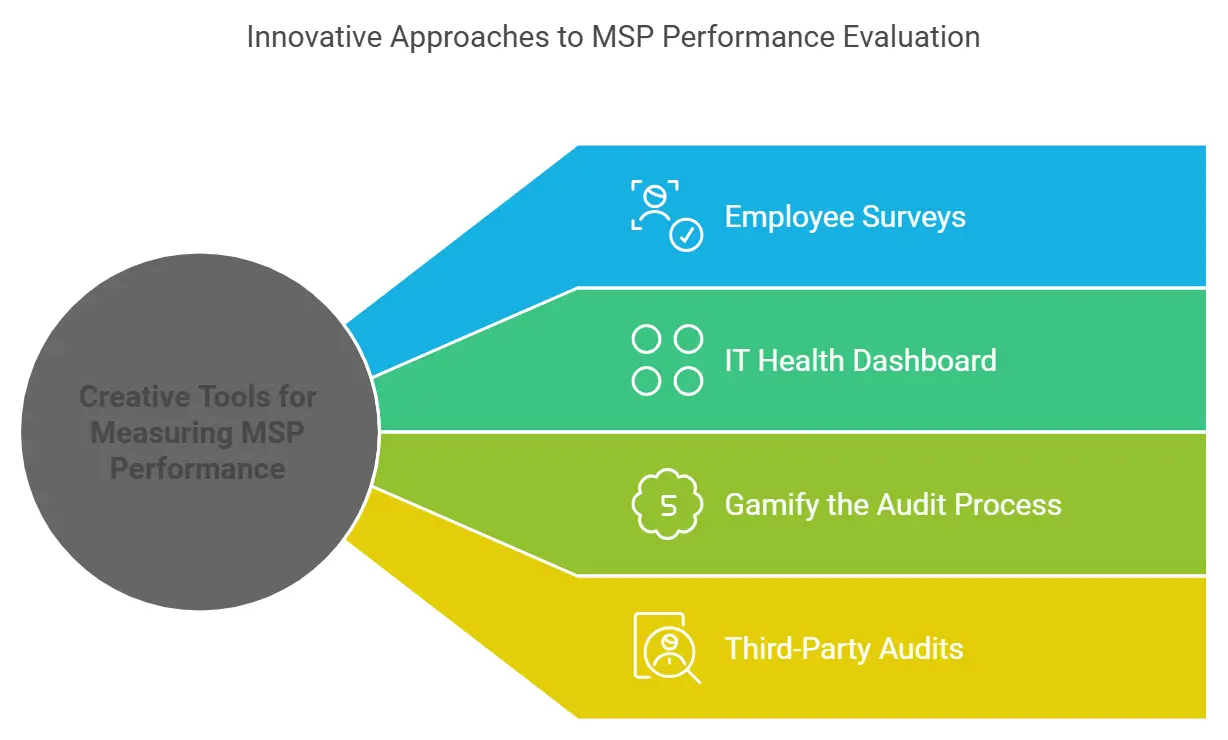Is your MSP falling short? Research from an Orange Matter study indicates that I.T. disruptions can lead to costs of $427 or more per minute.
You’re not alone if you’ve ever felt your Managed Service Provider (MSP) is leaving you high and dry. From missed deadlines to murky billing practices, dissatisfaction is alarmingly common. But here’s what Charles Bender, CEO of Attentus Technologies, says, “Effective MSP management starts with accountability—it’s the bridge between promises and performance.“
This blog isn’t just about keeping tabs on your MSP—it’s about wielding the power of audits to ensure your provider delivers real results.
Is Your MSP Delivering Real Value?Inefficient MSP services could cost your business time, money, and growth opportunities. |
Decoding Key Managed Services KPIs
Gut feelings can’t measure your MSP’s performance. Enter managed services KPIs, the tangible metrics that separate exceptional providers from underwhelming ones.
1. SLA Compliance: The Test of Time
Every MSP promises to resolve issues “quickly.” But do they? Dive into their SLA (Service Level Agreement) reports. Are they meeting their promised response and resolution times, or are deadlines perpetually missed?
Pro Tip: Ask your MSP for a quarterly SLA compliance report. It’s a non-negotiable.
2. Uptime Is Everything
Downtime costs companies an average of $9,000 per minute. If your network isn’t up and running consistently, your bottom line takes a hit. Does your MSP’s uptime match their marketing claims?
3. Proactive Problem-Solving
Here’s where the great MSPs shine. Managed services can cut your IT costs by 25% and increase your operational efficiency by 50%. Instead of reacting to problems, they predict them. An MSP that resolves issues before they impact your business is worth its weight in gold.
4. Transparent Reporting
How often does your MSP share detailed insights into your I.T. environment? A lack of clarity in reports often hides inefficiencies. Look for frequency, detail, and openness in their communication.
Creative Tools for Measuring MSP Performance
Every business audit needs tools, and assessing MSP performance is no different. But forget the boring spreadsheets—let’s get creative:
1. Employee Surveys: Your Secret Weapon
Your team interacts with the MSP daily. Create anonymous surveys to gather unfiltered feedback on their experiences with I.T. support.
2. I.T. Health Dashboard
Many MSPs provide dashboards to track your I.T. system’s performance. Use these to visualize uptime, ticket closures, and overall system health.
3. Gamify the Audit Process
Turn your audit into a game: set challenges like resolving recurring tickets or reducing downtime. Reward your MSP for achieving milestones—it’s a win-win!
4. Third-Party Audits: Objective Insights
Sometimes, an outsider’s perspective is invaluable. A third-party I.T. consultant can identify gaps in your MSP’s performance that you might overlook.
Why Audit Your MSP?
Imagine you’ve hired a chauffeur to drive your dream car, but the vehicle is always in the shop, and the driver shows up late. Frustrating, right? That’s what an underperforming MSP feels like.
Let’s explore why auditing your MSP isn’t just an option—it’s a necessity:
1. Uncover Hidden Inefficiencies
Issues with software quality carried a collective cost of $2.41 trillion for U.S. businesses in 2022, proving that even the slightest issues with quality or misalignment can quickly snowball.
Your MSP might be great at solving surface-level issues but ignoring systemic problems. A proper audit digs deep, identifying recurring I.T. hiccups that quietly sabotage productivity.
2. Ensure ROI
An MSP isn’t cheap, but the investment pays off only if the services lead to fewer downtimes, stronger cybersecurity, and seamless operations. Without auditing, how can you know your dollars are driving impact?
3. Keep Your Business Agile
As your business evolves, your I.T. needs change too. If your MSP isn’t adapting their services, you’re stuck in yesterday while your competitors speed into tomorrow.
| Explore More Cybersecurity Guides |
How to Audit Your MSP Step-by-Step
If auditing sounds overwhelming, don’t worry—we’ve broken it down into manageable steps:
Step 1: Identify Your Pain Points
Where are you struggling the most? Are outages frequent? Is the billing confusing? Start your audit by listing areas where you feel shortchanged.
Step 2: Request Comprehensive Reports
Your MSP should provide reports on SLA compliance, ticket resolution times, and system health. Compare these against their promised benchmarks.
Step 3: Analyze Cost vs. Benefit
Are you paying for services you don’t use? Cross-check invoices with services utilized. You might discover you’re spending on unnecessary features.
Step 4: Discuss Findings in a Review Meeting
Confront your MSP with the data. The goal isn’t to create friction but to encourage transparency and improvement.
Step 5: Create an Action Plan
Work collaboratively to address weaknesses. Define clear timelines and measurable outcomes.
Step 6: Reassess Quarterly
Auditing isn’t a one-time task. Regular reviews keep your MSP on their toes and aligned with your evolving needs.
Watch Out for These Red Flags
Even the best audits can reveal alarming signs. Here’s what to watch for:
- Vague Billing: If your invoices feel like hieroglyphics, it’s a problem. Demand clarity.
- Frequent Downtimes: If outages are a pattern, your provider might be cutting corners.
- Unresponsiveness: Are tickets falling into a black hole? Insist on accountability.
- Lack of Scalability: If your MSP isn’t proactively suggesting growth-friendly solutions, they’re holding you back.
Key Questions to Ask During Your MSP Audit
| Audit Area | Critical Questions | Why It Matters |
|---|---|---|
| Service Delivery | Are all services promised in the SLA being delivered effectively? | Ensures your MSP is meeting contractual obligations. |
| Cybersecurity | What proactive measures are being taken to protect against emerging threats? | Validates your provider’s ability to handle evolving risks. |
| Innovation | What new technologies or strategies has the MSP introduced in the past year? | Demonstrates whether the MSP is helping you stay competitive. |
| Customer Support | What is the average time to resolve tickets, and how are escalations handled? | Reveals responsiveness and efficiency in problem-solving. |
| Scalability | How does the MSP plan to support your business as it grows? | Confirms whether the provider can adapt to future needs. |
| Compliance | Are all industry and regulatory compliance standards being met consistently? | Protects your business from potential legal or financial risks. |
| Transparency | How frequently are performance reports shared, and are they easy to understand? | Builds trust and ensures you’re kept in the loop. |
Why Attentus Tech is Your Trusted Partner for MSP Performance Excellence
Your MSP is a critical partner, but their impact hinges on performance. By auditing key managed services KPIs, analyzing costs, and demanding transparency, you can ensure your provider contributes to your success.
At Attentus Technologies, we believe that your success is our success. One of our core values is building trusted relationships with our clients, ensuring we work as a seamless extension of your team. With 18 years of experience, a remarkable 97.5% CSAT rating, and an industry-leading 20-minute Reactive Hours Per Endpoint per Month (RHEM), we’ve perfected the art of proactive MSP management. This efficiency means fewer issues over time, ensuring smooth, uninterrupted operations. Our team, with an impressive 10-year average employee tenure, resolves most tickets in just 15 minutes, showcasing our commitment to swift and reliable support.
Ready to elevate your I.T. performance? Contact us today to schedule a free consultation and discover the difference our expertise can make!
| Discover Trusted Managed I.T. Services Near You: | ||
|---|---|---|
| Seattle | Kent | Renton |
| Kirkland | Auburn | Redmond |
| Bellevue | Tacoma | Federal Way |



